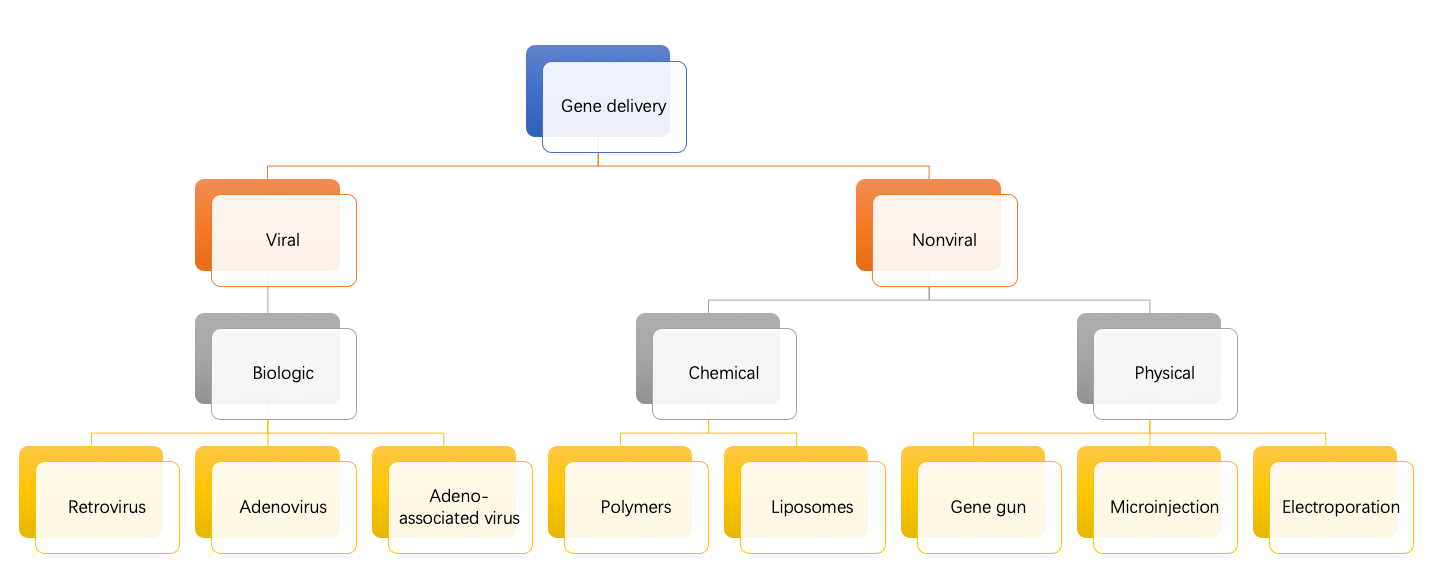Strategies for Gene Delivery
An Overview
Strategies for gene delivery can be broadly classified into three groups: chemical, biological, and physical. Biological strategies are also called transduction technologies. Chemical and physical strategies are called transfection technologies. No one way can be applied to all cells and all experiments. The method should be selected depending on your cell types and experimental needs, and should have high transfection efficiency, low cell toxicity, and minimal effects on normal physiology, and be easy to operate and repeat.
Focusing upon the biological methods, some viruses have been used for gene delivery including adenovirus, adeno-associated virus, herpesvirus, and lentivirus. Non-viral gene delivery methods can be divided into chemical and physical approaches. The chemical methods include certain polymers and lipids, while the physical methods utilize physical properties and forces to transport genetic material into cells.
 Figure 1. Organization of common gene delivery methods/vehicles.
Figure 1. Organization of common gene delivery methods/vehicles.
Direct Inoculation of DNAs and RNAs
Biological ways of direct inoculation of DNAs and RNAs are based on genetically engineered viruses to transfer non-viral genes into cells via viral deliveries. This method provides an operation to reach hard-to-transfect cell types for protein overexpression or knockdown.
Physical Methods
The physical methods for gene delivery have revolutionized the efficiency of non-viral gene transfer, in some cases reaching the efficiencies of viral vectors.
- Electroporation
This technique includes the delivery of a voltage (current) across the surface of cells, which will result in the spontaneous creation of pores in the plasma membranes. While the voltage is removed, the pores will close. And then, the voltage is applied and the pores open up, current will travel through the cell.
- Hydrodynamic intravascular injection
The hydrodynamic gene delivery via tail vein injection is an effective technique to deliver nucleic acids to the liver within small animals. This way of gene delivery using a rapid injection of a relatively large volume of DNA solution has opened a new way for gene therapy studies in vivo.
- Sonoporation
For sonoporation, it is a non-viral gene delivery system for improving plasmid DNA transfer across the biological cell membranes. It works via transient permeabilization of the cell membrane and by transferring therapeutic DNA effectively across tissue and into cells by application of ultrasound energy.
- Gene gun
Microparticles on the order of ~0.5-1μm are used in gene gun, and they are typically made of gold. It can ionize to have a positive charge, and the positive charge will interact well with DNA or RNA thanks to the negative charge on every phosphate group in the polynucleotide. This method is limited to exposed tissues, such as the epidermis, or cells in a plant leaf.
- Jet injection
Jet injection is to employ high pressure to deliver a liquid formulation of DNA. This technology has developed as an applicable alternative to viral or liposomal gene delivery systems. The major limitations to clinical use of this technique are the requirement for large amounts of DNA and the DNA degradation from the high-pressure delivery.
Chemical Methods
Chemical-based methods of gene delivery can utilize natural or artificial compounds to form particles that improve the transfer of target genes into cells. Chemical vectors usually enter cells via endocytosis and can protect genetic material from degradation.
- Poly(L-lysine) (PLL)
- Poly(ethylene imine) (PEI)
- Chitosan
- Liposomes
- Dioctadecylamidoglycylspermine (DOGS)
- N-[1-(2,3-dioleyloxy)propyl]-N,N,N-trimethylammonium chloride (DOTMA)
- Dioleoylphosphatidylethanolamine (DOPE)
Viral Vectors
Viruses, in theory, will yield up to 100% transduction efficiency in vitro. Practically, however, the range of 80% to 95% is more realistic. Some of the viruses used for gene delivery are adenovirus, adeno-associated virus, and certain retroviruses.
